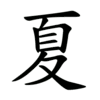夏
| ||||||||
Translingual
| Stroke order | |||
|---|---|---|---|
 | |||
| Stroke order | |||
|---|---|---|---|
 | |||
Han character
夏 (radical 35, 夊+7, 10 strokes, cangjie input 一山竹水 (MUHE), four-corner 10247, composition ⿱𦣻夂(GJK) or ⿱𦣻夊(HT))
Derived characters
References
- KangXi: page 245, character 12
- Dai Kanwa Jiten: character 5720
- Dae Jaweon: page 485, character 29
- Hanyu Da Zidian: volume 2, page 869, character 10
- Unihan data for U+590F
Chinese
| simp. and trad. |
夏 | |
|---|---|---|
| variant forms | ||
Glyph origin
| Historical forms of the character 夏 | |||||||||
|---|---|---|---|---|---|---|---|---|---|
| Shang | Western Zhou | Spring and Autumn | Warring States | Shuowen Jiezi (compiled in Han) | Liushutong (compiled in Ming) | ||||
| Bronze inscriptions | Oracle bone script | Bronze inscriptions | Bronze inscriptions | Bronze inscriptions | Chu Slip and silk script | Qin slip script | Ancient script | Small seal script | Transcribed ancient scripts |
 |
 |
 |
 |
 |
 |
 |
 |
 |
 |
| Characters in the same phonetic series (夏) (Zhengzhang, 2003) | |
|---|---|
| Old Chinese | |
| 榎 | *kraːʔ |
| 廈 | *sraːs, *ɡraːʔ |
| 嗄 | *sqʰraːs, *qraːds |
| 夏 | *ɡraːʔ, *ɡraːs |
In the oracle bone script, it was an ideogrammic compound (會意) : 日 (“sun”) + 頁 (“head; man”) – man under the scorching sun; summer.
Various variants were seen in the bronze inscriptions from the Spring and Autumn period. 止 (“foot”) was often added to the bottom of the man. Additionally, in the form shown above, the 日 was removed and 𦥑 (“two hands”) was added. The seal script inherits its form from this form, with 止 replaced with the related 夊.
Various forms were also seen from the Warring States period. The bamboo and silk script above shows a common form: 日 + 止 + 頁. The “ancient script” (古文) from Shuowen (labelled as the large seal script) has deviated significantly, with 止 becoming the related 足. The top part may be a corruption of 頁.
The current form is simplified from the seal script, with the removal of 𦥑 and the legs from 頁.
Etymology 1
- “great; Xia Dynasty; China; Chinese”
- Possibly related to 假 (OC *kraːʔ, *kraːs, “great”), 嘏 (OC *kraːʔ, “great”) and 廈 (OC *sraːs, *ɡraːʔ, “big house”) (Wang, 1980). Shi (2000) and Mair (2013) relate this word to Tibetan རྒྱ (rgya, “great; wide; width; size; expanse; China”).
- “magnificent colours; variegated”
- The sense “variegated” may be of a different origin. Compare Proto-Sino-Tibetan *Krā(H) (“variegated”) (Starostin), whence Tibetan བཀྲ (bkra, “variegated; bright; radiant; splendid”), Tibetan ཁྲ (khra, “many-coloured; variegated; mottled; striped”) and Burmese ကျား (kya:, “variegated; striped; chequered”). Possibly related to 騢 (OC *ɡraː, “horse with mixed red and white colour”).
Pronunciation
Definitions
夏
- (~朝) (historical) Xia Dynasty
- † (by extension) China; Chinese
- † great; grand; magnificent
- † magnificent colours; resplendent colours; variegated
- † Alternative form of 廈/厦 (shà, “big house”).
- A surname.
See also
Compounds
Etymology 2
Pronunciation
See also
| Seasons in Chinese · 四季 (sìjì, “four seasons”) (layout · text) | |||
|---|---|---|---|
| 春 (chūn, “spring”) | 夏 (xià, “summer”) | 秋 (qiū, “fall; autumn”) | 冬 (dōng, “winter”) |
Compounds
Etymology 3
Pronunciation
Compounds
|
|
References
- “夏”, in 漢語多功能字庫 (Multi-function Chinese Character Database), 香港中文大學 (the Chinese University of Hong Kong), 2014–
Japanese
Compounds
- 華夏 (Kaka)
- 夏時 (geshi)
- 夏朝 (Kachō, “Xia Dynasty”)
- 夏炉冬扇 (karotōsen)
- 夏至 (geshi)
- 夏臘, 夏﨟 (gerō)
- 昨夏 (sakka, “last summer”)
- 春夏秋冬 (shunkashūtō)
- 初夏 (shoka, “beginning summer”)
- 消夏, 銷夏 (shōka)
- 盛夏 (seika)
- 冬扇夏炉 (tōsenkaro)
- 晩夏 (banka, “ending summer”)
- 孟夏 (mōka)
- 立夏 (rikka, “first day of summer”)
- 冷夏 (reika)
- 解夏 (gege)
- 結夏 (ketsuge)
- 半夏 (hange)
Derived terms
- 夏茜 (natsuakane)
- 夏井 (Natsui)
- 夏犬 (natsuinu)
- 夏鶯 (natsu uguisu)
- 夏瓜 (natsuuri)
- 夏帯 (natsuobi)
- 夏草 (natsukusa)
- 夏茱萸, 夏胡頽子 (natsugumi)
- 夏越しの祓 (Nagoshi no Harae), 夏越し (Nagoshi)
- 夏蝉 (natsuzemi)
- 夏鳥 (natsudori)
- 夏場 (natsuba, “summertime”)
- 夏深し (natsufukashi)
- 夏祭, 夏祭り (natsu-matsuri)
- 棗 (natsume, “jujube”)
- 夏休, 夏休み (natsuyasumi, “summer break”)
- 夏山 (natsuyama)
- 夏の大三角 (Natsu no Daisankaku), 夏の大三角形 (Natsu no Daisankakkei)
- 常夏 (tokonatsu)
- 真夏 (manatsu, “midsummer”)
- 翌夏 (yokunatsu, “next summer”)
Proverbs
- 夏歌う者は冬泣く (natsu utau mono wa fuyu naku)
- 夏の小袖 (natsu no kosode)
- 夏も小袖 (natsu mo kosode)
See also
| Seasons in Japanese · 四季 (shiki, “four seasons”) (layout · text) | |||
|---|---|---|---|
| 春 (haru, “spring”) | 夏 (natsu, “summer”) | 秋 (aki, “fall; autumn”) | 冬 (fuyu, “winter”) |
Etymology 2
| Kanji in this term |
|---|
| 夏 |
| げ Grade: 2 |
| goon |
From Middle Chinese 夏 (MC ɦˠaH). The goon reading, so likely the initial borrowing.
Also used in the Man'yōshū (759 CE) as 借音 (shakuon) kana for ⟨ge1⟩.
Noun
- (Buddhism) summer according to the lunisolar calendar; the ninety days starting from the sixteenth day of the fourth month until the fifteenth day of the seventh month
Derived terms
- 夏解, 夏明き (geaki)
- 夏安居 (geango)
See also
- 安居 (ango)
Etymology 3
| Kanji in this term |
|---|
| 夏 |
| か Grade: 2 |
| kan’on |
From Middle Chinese 夏 (MC ɦˠaX).
The kan'on reading, so likely a later borrowing.
Proper noun
- the Xia dynasty (first dynasty of China)
- Short for 大夏 (Daika): Xia, one of the Sixteen Kingdoms
- Short for 西夏 (Seika): Western Xia, an empire during the Song dynasty
- a surname
- a male or female given name